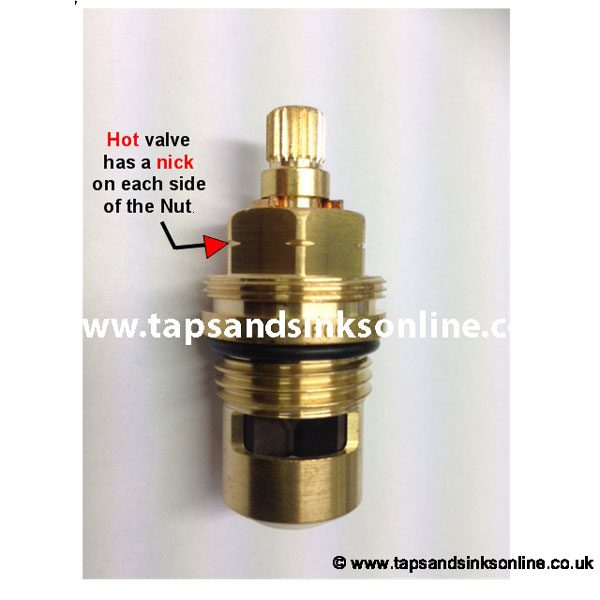Tap Valves : Clockwise and Anti-Clockwise explained
This post is dealing with ceramic (quarter turn) disc valves that by their nature open clockwise or anti-clockwise to turn (open) the water feed.
There are various types of valves (also known as Glands and known as Cartridges). All valves / glands / cartridges are explained in this post Are all kitchen Tap glands the same ?
If your Tap has twist turn handles then you most likely have a compression valve in your tap. This valve opens anticlockwise and closes clockwise. Whether you are replacing the valve that operates the hot or the cold water feed, the valve is the same i.e the valve on the cold water feed turns anti-clockwise and the valve on your hot water feed turns anti-clockwise so you could even swop the valves around and you would still be turngin the handles in the same direction.
However, with a ceramic disc valve (quarter turn valve) in a two lever tap, both valves are identical excecpt that one valve opens clockwise (usually the hot water feed) and the other valve opens anti-clockwise, usually the cold water feed. We say ‘usually’ because the exception is lever taps where the lever taps extend horizontally and this is explained in more detail below.
and clockwise opening valves are identical except that they open either
A Cold Valve opens Anti-clockwise (ACO) and a Hot Valve opens Clockwise (CO).
- A two lever tap usually has two valves known as ‘Hot’ (CO) and ‘Cold'(ACO).
- Usually these valves are distinguished by the colours red and blue underneath.
- Sometimes the seals underneath can be white or black in colour but as a rule of thumb the Hot (CO) Valve will also have a nick on every side of the nut to distinguish it from the Cold Valve of the same measurements / specifications.
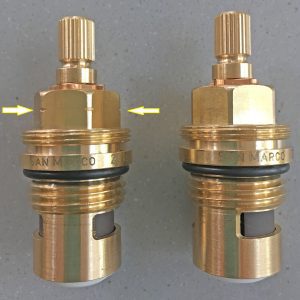
4276r Pair of Valves. The CO Valve has a nick on the side of the nut to distinguish from the ACO Valve which has no nick on the side of the nut. Other than this nick, both Valves appear identical.
We tend to think that a Cold water feed needs a ‘Cold’ valve and a Hot water feed needs a ‘hot’ water valve and that is usually correct BUT there are exceptions e.g. where you have a two lever tap and BOTH levers turn in the SAME direction (in which case you require two Valves that Open in the Same direction (usually two Valves that open Anti-Clockwise e.g. ‘Cold’ and sometimes you have Bridge Lever Taps where both Levers are Horizontal in the ‘Closed / Off’ position and are turned towards the centre of the Tap to turn on, and the only way to achive this is by having a Valve that opens Clockwise on the Right Lever i.e. a ‘Hot’ CO Valve in the Cold Water Feed and a ‘Cold’ ACO Valve in the Hot Water Feed.
That is why it is better, unless your Tap is a standard Two Lever Tap where both levers are pulled towards you to turn the water on and off and the Hot Water Feed is on your Left and the Cold Water Feed is on your right, to observe what way you turn your lever to turn you water on / off. That will actully tell you what vavle you need.
Standard Two Lever Tap.
Pull the levers towards the body to turn the water on
We tend to think that a Cold water feed needs a ‘Cold’ valve and a Hot water feed needs a ‘hot’ water valve and that is usually correct BUT there are exceptions e.g. where you have a two lever tap and BOTH levers turn in the SAME direction (in which case you require two Valves that Open in the Same direction (usually two Valves that open Anti-Clockwise e.g. ‘Cold’ and sometimes you have Bridge Lever Taps where both Levers are Horizontal in the ‘Closed / Off’ position and are turned towards the centre of the Tap to turn on, and the only way to achive this is by having a Valve that opens Clockwise on the Right Lever i.e. a ‘Hot’ CO Valve in the Cold Water Feed and a ‘Cold’ ACO Valve in the Hot Water Feed.
That is why it is better, unless your Tap is a standard Two Lever Tap where both levers are pulled towards you to turn the water on and off and the Hot Water Feed is on your Left and the Cold Water Feed is on your right, to observe what way you turn your lever to turn you water on / off. That will actully tell you what valve you need.
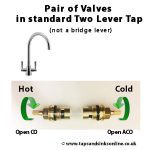
Valves with CO AND ACO Symbols 2 LEVER TAP
So it’s logical here i.e. the Cold water feed requies a Valve that turns anticlockwise i.e you pull the cold lever towards you (and are turning the valve inside the tap anticlockwise) so you need a Cold Valve.
Bridge Lever Tap
See this example here
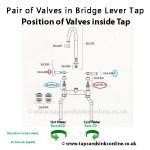
Bridge lever valves with CO AND ACO Symbols
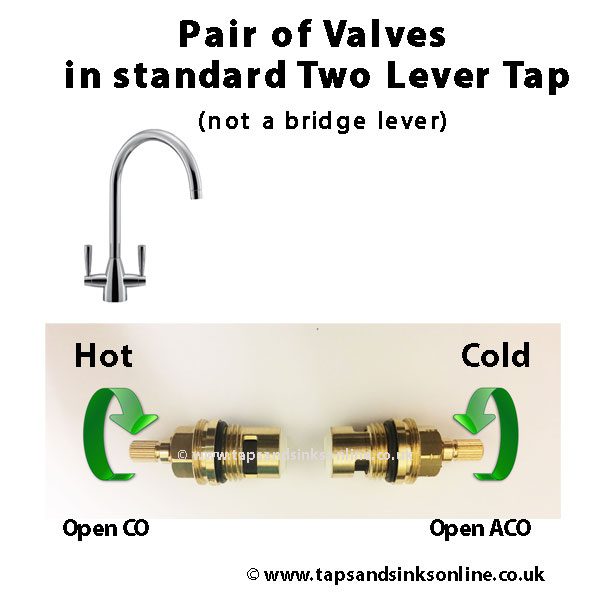
Valves with CO AND ACO Symbols 2 LEVER TAP
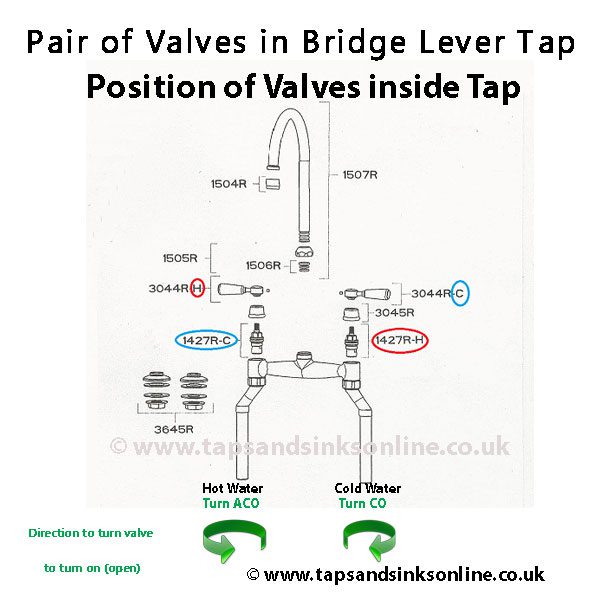
Bridge lever valves with CO AND ACO Symbols
Then you can have a pair of pillar taps like here :
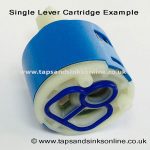
Single Lever Cartridge Example
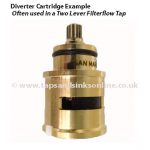
Diverter Cartridge Example
All you can do to see which valve is faulty (without removing the valves to see if there is any thing obvious on your valve to indicate that it is worn) is to run the hot water in your tap. Then turn it off and see if the drip continues to be warm or turns cold. If it turns cold then it is most likely the cold valve that is the problem. If it remains hot then it is most likely your hot valve.
If you have a filtered tap with 3 valve and you have narrowed it down to a problem on the cold side then it is far harder to distinguish which cold valve is at fault i.e. mains cold valve or filtered cold valve. What you could do is buy both valves and try the new one in both i.e. test it in one and if drip continues test it in the other one and see which ‘cold’ valve needs replacing. Remember that if you fit a new valve then it is ‘used’ and can’t be returned for a refund if not required.
Summary of useful guides:
7 easy steps to replace a valve
Posted in: Helpful Tips, How to....
Leave a Comment (0) ↓
